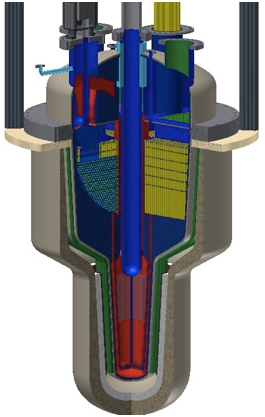
ADSMS core assembly. The hydrogen fluorid (Hf) absorber shell (teal cylinders located at top center of figure) is show in up and down positions. (Credit: Peter McIntyre.)
According to a recent press release, Texas A&M’s Peter McIntyre is developing the technology capable of destroying the hazardous waste from spent Nuclear reactor fuel rods, while at the same time, producing safe nuclear power which could power to world for thousands of years to come.
The key to McIntyre’s plan is the ability to remove what are known as transuranics from spent fuel rods. The rods are the waste product of nuclear fission and the transuranics are the hazardous chemical elements, created within the fuel rods during fission process, and are what make the spent fuel rods such a waste disposal nightmare. Current estimates are that the amount of spent nuclear fuel, being housed in pools at nuclear facilities until a better option is found, currently stands at 65,000 tons.
“In my opinion, the only way to properly deal with transuranics is to destroy them,” McIntyre said. “They are an unthinkable hazard if they ever get into the biosphere. There has long been discussion that we could find a site like Yucca Mountain that’s so isolated from groundwater and so stable geologically that we could say with confidence it will be the same 100,000 years from now as it is today, and that burying fuel there, closing the door and forgetting it is something we can responsibly do. I don’t buy those arguments.”
“In the same process by which we extract the transuranics from the spent fuel, we also extract the uranium so it can be re-used as an ongoing energy resource to provide nuclear energy for the next several thousand years,” McIntyre said.
If it works, McIntyre’s plan would destroy the transuranics in the spent fuel rods, and at the same time it would recover useful uranium to be used in further nuclear fission to produce power. The design is known as ADSMS which stands for accelerator-driven subcritical fission in a molten salt core. In simplistic terms, the process chops up the spent fuel rods, dissolves them in molten salts, and then uses subcritical nuclear fission to extract and destroy the transuranics.
“In the same process by which we extract the transuranics from the spent fuel, we also extract the uranium so it can be re-used as an ongoing energy resource to provide nuclear energy for the next several thousand years,” McIntyre said.
“We are preparing a proposal to the DOE to build and put into operation a first model of this strong-focusing cyclotron,” McIntyre said. “It would be quite an advance in the field of accelerator physics unto itself. But most particularly, for the first time, it will make it feasible to drive a subcritical fission core capable of destroying transuranics at the same rate they are made in a power reactor.”
The complete article can be found online at the Texas A&M University web site. Also, more information about McIntyre and his research is available at: http://people.physics.tamu.edu/mcintyre/.
![Herbal Reference Substances are Key to Everyday Products <!-- AddThis Sharing Buttons above -->
<div class="addthis_toolbox addthis_default_style " addthis:url='http://newstaar.com/herbal-reference-substances-are-key-to-everyday-products/3512112/' >
<a class="addthis_button_facebook_like" fb:like:layout="button_count"></a>
<a class="addthis_button_tweet"></a>
<a class="addthis_button_pinterest_pinit"></a>
<a class="addthis_counter addthis_pill_style"></a>
</div>When it comes to quality control testing and the development of new products, Botanical Reference Materials (BRMs), also known as Herbal References are critically important. To help companies ultimately obtain all-important FDA approval, the Food and Drug Administration provides in its guidance a recommendation that […]<!-- AddThis Sharing Buttons below -->
<div class="addthis_toolbox addthis_default_style addthis_32x32_style" addthis:url='http://newstaar.com/herbal-reference-substances-are-key-to-everyday-products/3512112/' >
<a class="addthis_button_preferred_1"></a>
<a class="addthis_button_preferred_2"></a>
<a class="addthis_button_preferred_3"></a>
<a class="addthis_button_preferred_4"></a>
<a class="addthis_button_compact"></a>
<a class="addthis_counter addthis_bubble_style"></a>
</div>](http://newstaar.com/wp-content/uploads/2021/02/Achillea_millefolium_flowers-100x100.jpg)
![Quality Electrochemical Biosensors are Critical for Medical, Food and Chemical Industry <!-- AddThis Sharing Buttons above -->
<div class="addthis_toolbox addthis_default_style " addthis:url='http://newstaar.com/quality-electrochemical-biosensors-are-critical-for-medical-food-and-chemical-industry/3512086/' >
<a class="addthis_button_facebook_like" fb:like:layout="button_count"></a>
<a class="addthis_button_tweet"></a>
<a class="addthis_button_pinterest_pinit"></a>
<a class="addthis_counter addthis_pill_style"></a>
</div>A number of industries have, at their core, a need to frequent or even continuous analysis of biological media. These include the medical and pharmaceutical fields, biotech firms, and food and chemical companies. To maintain quality standards and develop new products, these industries rely heavily […]<!-- AddThis Sharing Buttons below -->
<div class="addthis_toolbox addthis_default_style addthis_32x32_style" addthis:url='http://newstaar.com/quality-electrochemical-biosensors-are-critical-for-medical-food-and-chemical-industry/3512086/' >
<a class="addthis_button_preferred_1"></a>
<a class="addthis_button_preferred_2"></a>
<a class="addthis_button_preferred_3"></a>
<a class="addthis_button_preferred_4"></a>
<a class="addthis_button_compact"></a>
<a class="addthis_counter addthis_bubble_style"></a>
</div>](http://newstaar.com/wp-content/uploads/2020/10/Electrochemical-Biosensor-100x100.jpg)
![Company Develops Industrial Mixers Well-Suited for both Fragile and Explosive Products <!-- AddThis Sharing Buttons above -->
<div class="addthis_toolbox addthis_default_style " addthis:url='http://newstaar.com/company-develops-industrial-mixers-well-suited-for-both-fragile-and-explosive-products/3512071/' >
<a class="addthis_button_facebook_like" fb:like:layout="button_count"></a>
<a class="addthis_button_tweet"></a>
<a class="addthis_button_pinterest_pinit"></a>
<a class="addthis_counter addthis_pill_style"></a>
</div>Industrial drum mixers are normally applied to blend mixes of varying viscosities such as adhesive slurries or cement. Some of these mixers have the capability of blending mixes of very different particle sizes such as fruit and ice cream, and gravel and cement slurry. The […]<!-- AddThis Sharing Buttons below -->
<div class="addthis_toolbox addthis_default_style addthis_32x32_style" addthis:url='http://newstaar.com/company-develops-industrial-mixers-well-suited-for-both-fragile-and-explosive-products/3512071/' >
<a class="addthis_button_preferred_1"></a>
<a class="addthis_button_preferred_2"></a>
<a class="addthis_button_preferred_3"></a>
<a class="addthis_button_preferred_4"></a>
<a class="addthis_button_compact"></a>
<a class="addthis_counter addthis_bubble_style"></a>
</div>](http://newstaar.com/wp-content/uploads/2020/06/bandeau-sofragir2-100x100.jpg)